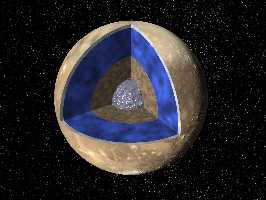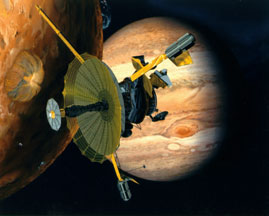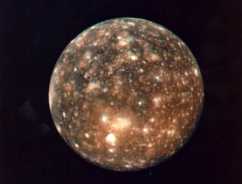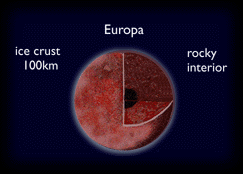This is a drawing of the interior of Europa.
Click on image for full size
Interior of Europa
The diagram shows possibilities for the interior structure of Europa. There is a core of rocky material buried inside, overlain with ice of various phases.
The diagram shows that there may be an ocean of water beneath the surface crust of ice on Europa. This is because the temperature inside Europa may be just right for water.
The lack of craters on the surface of Europa provides evidence that activity which resurfaced Europa persisted for far longer than activity which changed the surface of Ganymede. Fresh ice, as well as evidence of flowing liquid cover the surface of Europa.
If the temperature inside Europa is just right, then there might still be water inside. Such an environment might prove to be habitable for life.
You might also be interested in:

Minerals occur naturally on rocky planets and form the building blocks of rocks. They are non-living, solid, and, like all matter, are made of atoms of elements. There are many different types of minerals
...more
Europa was first discovered by Galileo Galilei in 1610, making it one of the Galilean Satellites. Europa is Jupiter's 4th largest moon, 670,900 km from Jupiter. With a diameter that is about half the distance
...more
The diagram to the left shows a cutaway of the possible interior structure of Ganymede, based on recent measurements by the Galileo spacecraft. It shows a small core of metal, overlain with some rocky
...more
The Galileo spacecraft was launched on October 19, 1989. Galileo had two parts: an orbiter and a descent probe that parachuted into Jupiter's atmosphere. Galileo's primary mission was to explore the Jovian
...more
The Galileo spacecraft, which has been orbiting Jupiter since 1995, has finally reached the end of its road. On September 21, 2003, Galileo will make a fiery plunge into Jupiter's atmosphere and be vaporized.
...more
Amalthea was discovered by E Barnard in 1872. Of the 17 moons it is the 3rd closest to Jupiter, with a standoff distance of 181,300 km. Amalthea is about the size of a county or small state, and is just
...more
Callisto was first discovered by Galileo in 1610, making it one of the Galilean Satellites. Of the 60 moons it is the 8th closest to Jupiter, with a standoff distance of 1,070,000 km. It is the 2nd largest
...more















